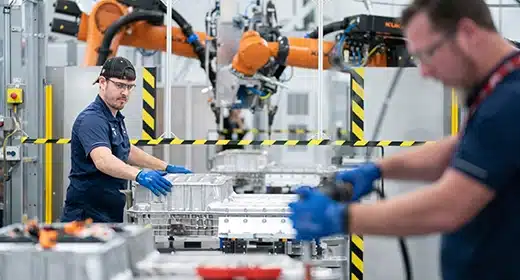Expect new battery chemistries for electric vehicles and a manufacturing boost thanks to government funding this year.
 Every year the world runs more and more on batteries. Electric vehicles passed 10% of global vehicle sales in 2022, and they’re on track to reach 30% by the end of this decade.
Every year the world runs more and more on batteries. Electric vehicles passed 10% of global vehicle sales in 2022, and they’re on track to reach 30% by the end of this decade.
Policies around the world are only going to accelerate this growth: recent climate legislation in the US is pumping billions into battery manufacturing and incentives for EV purchases. The European Union, and several states in the US, passed bans on gas-powered vehicles starting in 2035.
The transition will require lots of batteries—and better and cheaper ones.
Most EVs today are powered by lithium-ion batteries, a decades-old technology that’s also used in laptops and cell phones. All those years of development have helped push prices down and improve performance, so today’s EVs are approaching the price of gas-powered cars and can go for hundreds of miles between charges. Lithium-ion batteries are also finding new applications, including electricity storage on the grid that can help balance out intermittent renewable power sources like wind and solar.
But there is still lots of room for improvement. Academic labs and companies alike are hunting for ways to improve the technology—boosting capacity, speeding charging time, and cutting costs. The goal is even cheaper batteries that will provide cheap storage for the grid and allow EVs to travel far greater distances on a charge.
At the same time, concerns about supplies of key battery materials like cobalt and lithium are pushing a search for alternatives to the standard lithium-ion chemistry.
In the midst of the soaring demand for EVs and renewable power and an explosion in battery development, one thing is certain: batteries will play a key role in the transition to renewable energy. Here’s what to expect in 2023.
A radical rethink
Some dramatically different approaches to EV batteries could see progress in 2023, though they will likely take longer to make a commercial impact.
One advance to keep an eye on this year is in so-called solid-state batteries. Lithium-ion batteries and related chemistries use a liquid electrolyte that shuttles charge around; solid-state batteries replace this liquid with ceramics or other solid materials.
This swap unlocks possibilities that pack more energy into a smaller space, potentially improving the range of electric vehicles. Solid-state batteries could also move charge around faster, meaning shorter charging times. And because some solvents used in electrolytes can be flammable, proponents of solid-state batteries say they improve safety by cutting fire risk.
Solid-state batteries can use a wide range of chemistries, but a leading candidate for commercialization uses lithium metal. Quantumscape, for one, is focused on that technology and raised hundreds of millions in funding before going public in 2020. The company has a deal with Volkswagen that could put its batteries in cars by 2025.
But completely reinventing batteries has proved difficult, and lithium-metal batteries have seen concerns about degradation over time, as well as manufacturing challenges. Quantumscape announced in late Decemberit had delivered samples to automotive partners for testing, a significant milestone on the road to getting solid-state batteries into cars. Other solid-state-battery players, like Solid Power, are also working to build and test their batteries. But while they could reach major milestones this year as well, their batteries won’t make it into vehicles on the road in 2023.
Solid-state batteries aren’t the only new technology to watch out for. Sodium-ion batteries also swerve sharply from lithium-ion chemistries common today. These batteries have a design similar to that of lithium-ion batteries, including a liquid electrolyte, but instead of relying on lithium, they use sodium as the main chemical ingredient. Chinese battery giant CATL reportedly plans to begin mass-producing them in 2023.
Sodium-ion batteries may not improve performance, but they could cut costs because they rely on cheaper, more widely available materials than lithium-ion chemistries do. But it’s not clear whether these batteries will be able to meet needs for EV range and charging time, which is why several companies going after the technology, like US-based Natron, are targeting less demanding applications to start, like stationary storage or micromobility devices such as e-bikes and scooters.
Today, the market for batteries aimed at stationary grid storage is small—about one-tenth the size of the market for EV batteries, according to Yayoi Sekine, head of energy storage at energy research firm BloombergNEF. But demand for electricity storage is growing as more renewable power is installed, since major renewable power sources like wind and solar are variable, and batteries can help store energy for when it’s needed.
Lithium-ion batteries aren’t ideal for stationary storage, even though they’re commonly used for it today. While batteries for EVs are getting smaller, lighter, and faster, the primary goal for stationary storage is to cut costs. Size and weight don’t matter as much for grid storage, which means different chemistries will likely win out.
One rising star in stationary storage is iron, and two players could see progress in the coming year. Form Energy is developing an iron-air battery that uses a water-based electrolyte and basically stores energy using reversible rusting. The company recently announced a $760 million manufacturing facility in Weirton, West Virginia, scheduled to begin construction in 2023. Another company, ESS, is building a different type of iron battery that employs similar chemistry; it has begun manufacturing at its headquarters in Wilsonville, Oregon.
Shifts within the standard
Lithium-ion batteries keep getting better and cheaper, but researchers are tweaking the technology further to eke out greater performance and lower costs.
Some of the motivation comes from the price volatility of battery materials, which could drive companies to change chemistries. “It’s a cost game,” Sekine says.
Cathodes are typically one of the most expensive parts of a battery, and a type of cathode called NMC (nickel manganese cobalt) is the dominant variety in EV batteries today. But those three elements, in addition to lithium, are expensive, so cutting some or all of them could help decrease costs.
This year could be a breakout year for one alternative: lithium iron phosphate (LFP), a low-cost cathode material sometimes used for lithium-ion batteries.
Recent improvements in LFP chemistry and manufacturing have helped boost the performance of these batteries, and companies are moving to adopt the technology: LFP market share is growing quickly, from about 10% of the global EV market in 2018 to about 40% in 2022. Tesla is already using LFP batteries in some vehicles, and automakers like Ford and Volkswagen announced that they plan to start offering some EV models with the chemistry too.
Though battery research tends to focus on cathode chemistries, anodes are also in line to get a makeover.
Most anodes in lithium-ion batteries today, whatever their cathode makeup, use graphite to hold the lithium ions. But alternatives like silicon could help increase energy density and speed up charging.
Silicon anodes have been the subject of research for years, but historically they haven’t had a long enough lifetime to last in products. Now though, companies are starting to expand production of the materials.
In 2021, startup Sila began producing silicon anodes for batteries in a wearable fitness device. The company was recently awarded a $100 million grant from the Department of Energy to help build a manufacturing facility in Moses Lake, Washington. The factory will serve Sila’s partnership with Mercedes-Benz and is expected to produce materials for EV batteries starting in 2025.
Other startups are working to blend silicon and graphite together for anodes. OneD Battery Sciences, which has partnered with GM, and Sionic Energycould take additional steps toward commercialization this year.
Policies shaping products
The Inflation Reduction Act, which was passed in late 2022, sets aside nearly $370 billion in funding for climate and clean energy, including billions for EV and battery manufacturing. “Everybody’s got their mind on the IRA,” says Yet-Ming Chiang, a materials researcher at MIT and founder of multiple battery companies.
The IRA will provide loans and grants to battery makers in the US, boosting capacity. In addition, EV tax credits in the law incentivize automakers to source battery materials in the US or from its free-trade partners and manufacture batteries in North America. Because of both the IRA’s funding and the EV tax credit restrictions, automakers will continue announcing new manufacturing capacity in the US and finding new ways to source materials.
All that means there will be more and more demand for the key ingredients in lithium-ion batteries, including lithium, cobalt, and nickel. One possible outcome from the IRA incentives is an increase in already growing interest around battery recycling. While there won’t be enough EVs coming off the road anytime soon to meet the demand for some crucial materials, recycling is starting to heat up.
CATL and other Chinese companies have led in battery recycling, but the industry could see significant growth in other major EV markets like North America and Europe this year. Nevada-based Redwood Materials and Li-Cycle, which is headquartered in Toronto, are building facilities and working to separate and purify key battery metals like lithium and nickel to be reused in batteries.
Li-Cycle is set to begin commissioning its main recycling facility in 2023. Redwood Materials has started producing its first product, a copper foil, from its facility outside Reno, Nevada, and recently announced plans to build its second facility beginning this year in Charleston, South Carolina.
With the flood of money from the IRA and other policies around the world fueling demand for EVs and their batteries, 2023 is going to be a year to watch.









































